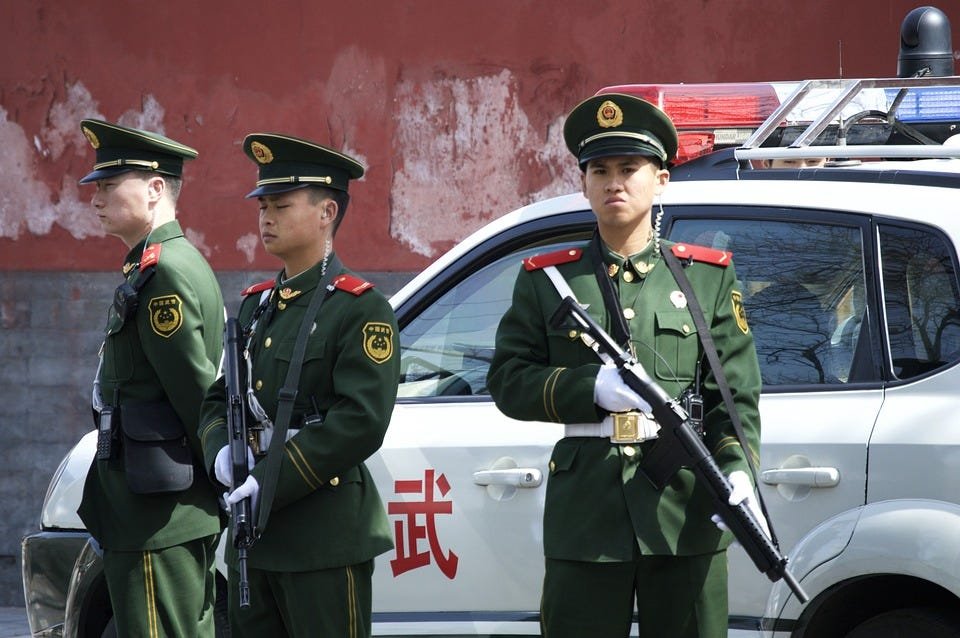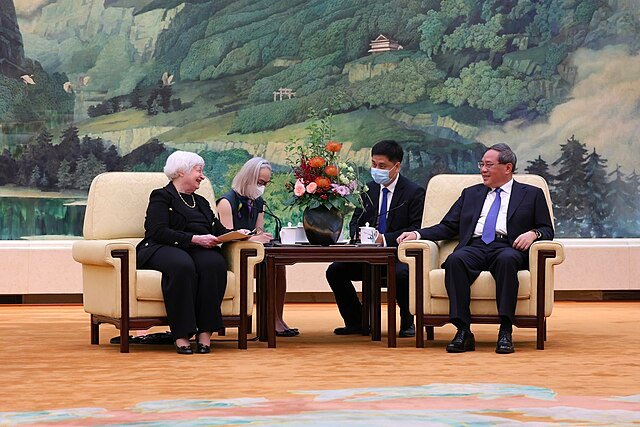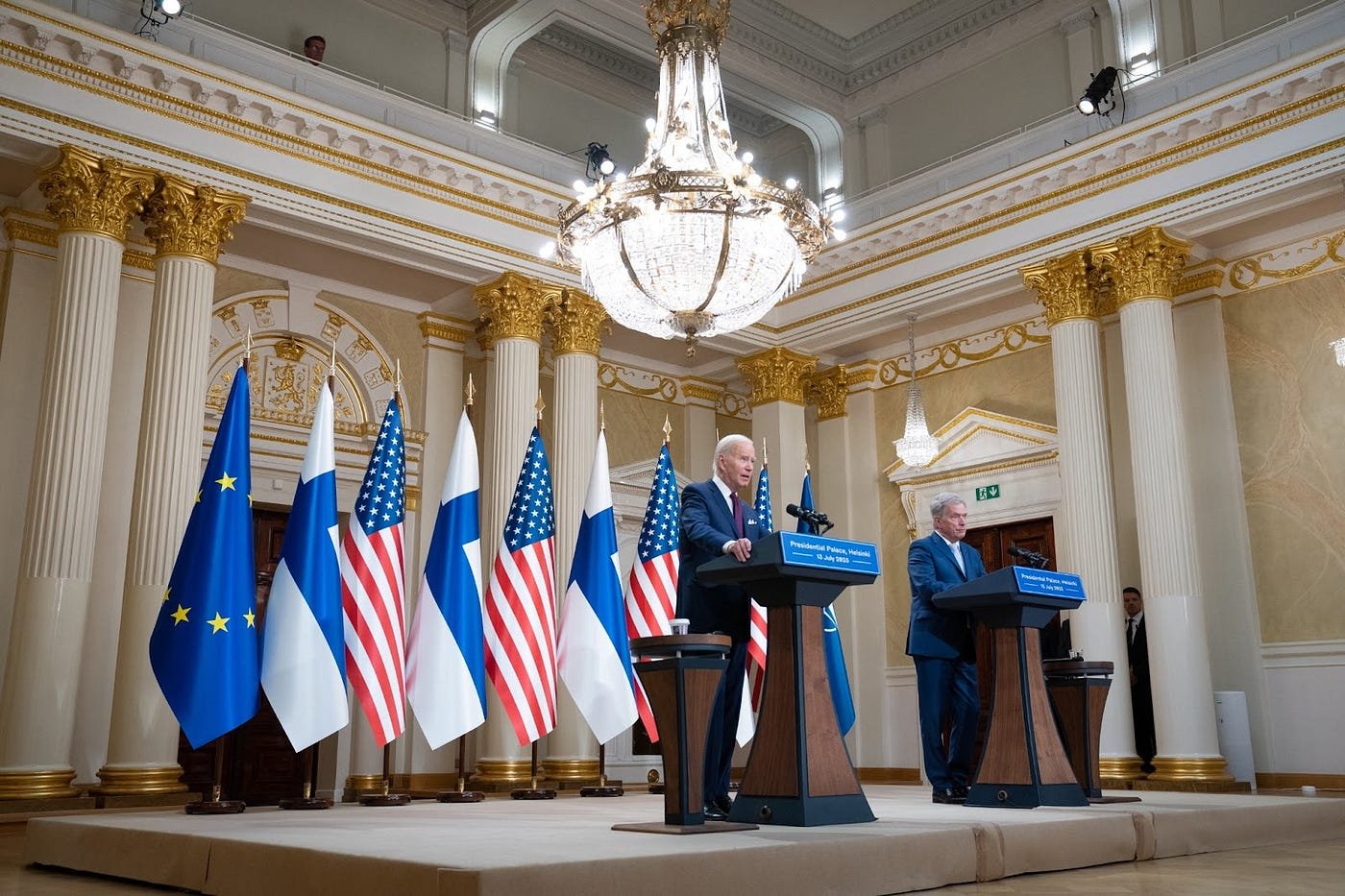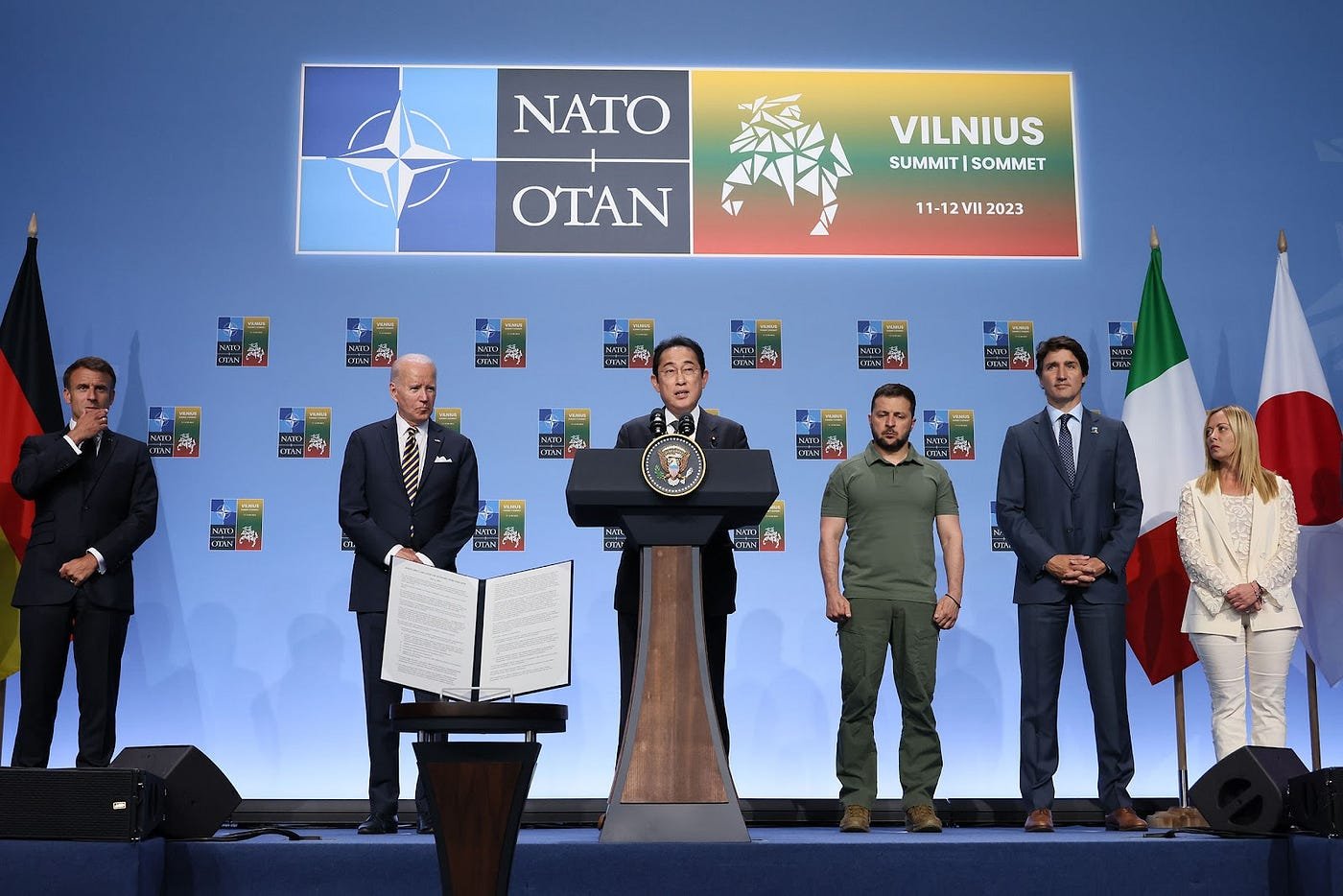Friday News Roundup – July 14, 2023
With Congress back in session this week, attention has once again been on the House of Representatives, as the House GOP leadership has moved ahead with a series of amendments related to GOP priorities for this year’s National Defence Authorization Act (NDAA). Combined with Alabama Senator Tommy Tuberville’s block on military promotions due to DOD policy, at the intersection of war planning and our culture wars, we see the once bipartisan consensus around the NDAA giving way to a 219-210 vote. Still there is the split between the House and the Senate priorities, as well as intra-GOP divisions over Ukraine illustrated in some of the House amendment votes.
President Biden’s trips abroad continued to reinforce close relationships with allies—with stops in the United Kingdom, Vilnius NATO summit, and U.S.-Nordic meeting in Helsinki. Despite comments here and there, the NATO summit and resulting G-7 security assurances for Kyiv sought to illustrate western unity, while cautious optimism about Sweden’s entry to NATO follows Erdogan’s shift in rhetoric. The White House will hope to highlight the successes of this trip—as well as another reassuring set of economic data—in contrast to the GOP priorities highlighted in the NDAA debate.
This week Joshua C. Huminski, the Director of the Mike Rogers Center for Intelligence & Global Affairs convened two roundtables. Opening the week with Ms. Emma Salisbury of the Ministry of Defence, CSPC explored the challenges of naval modernization and the U.S. pivot, and the UK’s tilt, to the Indo-Pacific. On Tuesday, he hosted Dr. Ian Garner to discuss his new book “Z Generation”, a disturbing look at the rise of fascism in Russia, what it means for Russian identity, and how it could affect the course of the war against Ukraine and relations with the West. Huminski is reviewing “Z Generation” this weekend for the Diplomatic Courier.
For the Diplomatic Courier, last Saturday, Huminski reviewed Scott Shapiro’s “Fancy Bear Goes Phishing”. A deeply enlightening and oddly charming look at the world of cyber attackers, Shapiro provides a Computer Science 101 course along with his narrative of five key hacks he finds are illustrative of cyber vulnerabilities.
Huminski also offered his thoughts for a special edition of the Courier ahead of the NATO Summit in Vilnius on how the West should think about ensuring Ukraine’s long-term security beyond membership in the alliance.
In this week’s roundup, Ethan Brown looks at what the U.S. decision to provide cluster munitions to Ukraine indicates about the nature of the conflict and the state of our supply base. Dan Mahaffee comments on the expansive definitions of national security behind de-risking talk, while Elise covers the Chinese restrictions on critical minerals for semiconductors. Veera Parko provides an update on the Biden Helsinki visit, and Hidetoshi Azuma discusses the NATO-Japan relationship.
Cluster Munitions and Ukraine
Ethan Brown
A cannon crew member with 7th Infantry Division, Joint Base Lewis-McChord, Washington, prepares 155 mm artillery shells during a combined arms exercise in February at Yakima Training Center, Washington. (U.S. Army photo by Sgt. Cody Quinn, 28th Public Affairs Detachment)
Another month, another war-winning, tide-turning capability that was once sacrosanct is now headed Eastward to support Ukraine’s counteroffensive against Russia. The current issues alighting the policy and defense spheres aflame is the Biden Administration's decision to provide Ukraine with Cluster Munitions. Doing so is a high-risk, volatile and questionable decision, particularly at a time when the risk for confrontation and expansion of the conflict is unquestionably high. But more importantly, the use of these munitions risks ceding some of the moral high ground which Ukraine has fought so hard to defend after Moscow’s fateful decision to conduct this illegitimate operation more than a year ago.
Cluster weapons are a stockpile item of which the United States has significant quantities. There is good reason for this: the last time the United States military employed these weapons in combat was in the 2003 invasion of Iraq (although an alleged classified use of such munitions was reported in Yemen in 2009). It ceased producing these weapons in 2008 and fully phased them out of inventory in 2016. These weapons were deemed unusable in the gray fog of the War on Terror’s authorities on account of their risk to civilians being too great. Let that reality sink in for a moment.
These weapons have a well-earned, and dark, reputation for causing harm to civilians. If the following analysis doesn’t prove this reality, consider that cluster munitions remain widely employed by other militaries abroad: these include Russia in Kharkiv in September 2022, in Syria in 2012 (also Russia), In Israel in 2006, Hezbollah fired over 100 cluster rockets contributing to nearly one million unexploded bomblets, and going further back to Chechnya, Kosovo, Iraq I, Russia’s invasion of Afghanistan in 1979, and the Cold War, highlighted by the tragedy of the Vietnam War. In Vietnam, the International Committee for the Red Cross estimates that there are as many as 27 million unexploded bomblets remaining throughout the region, which have contributed to more than 10,000 civilian casualties to date.
In March of 2022 in this Roundup space, I cautioned that Ukrainian war crimes should be treated just as seriously as those committed (irrefutably and inexcusably) by the Russian aggressors. Use of cluster munitions directly impacts civilians, the likes of which the entire world has condemned Russia for to date for its use of these very munitions. The unconscionable defense of this decision by National Security Advisor Jake Sullivan in an press conference was summarized by blaming Russia for having already dispensed countless cluster munitions in Eastern Ukraine: “The argument I’m making is that Russia has already spread tens of millions of these bomblets across Ukrainian territory,” said Sullivan. “So we have to ask ourselves: Is Ukraine’s use of cluster munitions on that same land actually that much of an addition of civilian harm, given that that area is going to have to be de-mined regardless?” Russia is reported to have used a chemical aerosol munition with suffocating effect in Donetsk in June, and chloropicrin grenades in December, but this doesn’t justify providing Ukraine with chemical weapons to counter Russia’s aggression. Cluster munitions, though not precisely as destructive or unnecessary to military tactics as chemical weapons, is certainly not a non sequitur either.
It is noteworthy that Congress is not swept up in the momentary passion of yet another Ukraine aid package with no conditions or restrictions: a bipartisan group of 27 lawmakers criticized the decision to ship cluster munitions to Ukraine. Allies and NATO partners alike have also echoed the criticism of the decision.
The reason cluster munitions are such a volatile topic is that they kill civilians. This is not hyperbole, nor sensationalism, or rhetoric. Cluster munitions kill civilians due to an unpredictable and high dud rate. The Defense Department asserts that the approximate dud rate for the M77 Dual Purpose Improved Conventional Munition (DPICM) is no greater than 2.35 percent, but historical data indicates fail-rates as high as 14 percent, while Russia’s faulty cluster munitions have a reported fail rate of as high as 40 percent.
These canisters contain dozens of miniature munitions, which are released by a predetermined dispersal pattern intended to distribute the submunitions over a wide area, making them extremely effective against large formations of personnel, convoys, and armored vehicles in the open. However, if the Dragon’s Teeth and evolving Russian tactics are indicative of the reality on the ground, the aggressors have learned to more effectively disperse their personnel, protect them in hardened structures, and avoid the target-rich environment which has made Ukrainian artillery so effective to date. This is not a tactically feasible environment for the use of cluster munitions.
US military doctrine (Joint Publication 3-09.3), which dictates protocols for aerial delivered fires, asserts that “cluster munitions are effective against area targets such as troops and vehicles in the open, but not against hardened targets, and are not advisable for targets where friendly troops may be affected by the immediate strike or by unexploded ordnance. Cluster munitions that dud may affect the mobility of certain units.” Further, the intended DPICMs being prepared for Ukraine’s forces are not those of the aerial-delivered category, but the M864, fired from the M777 155mm howitzer and contains 76 fragmentary submunitions with a dud rate that can reach six percent. Artillery, not even those operated by highly efficient and proficient forces such as Ukraine’s (now) veterans of artillery warfare, can achieve precision engagement with such munitions as compared to aerial-delivered cluster munitions.
The blame lies in a lagging production capacity to provide Ukraine with ample artillery shells, deemed the first “surefire” means of winning the conflict (before long range missiles, tanks, fighter jets, and more besides became in vogue). But this is no justification with the United States enabling the same barbaric weapons and tactics to enter the fray as those employed by the universally-decried aggressor in this conflict.
Defining National Security in a (Less) Globalized World
Dan Mahaffee
(Police in Tiananmen Square - Photo Credit Max Pixel)
If the past paradigm of globalization was based on speed, low costs, and maximum efficiency, the new debate of de-risking rests on the definition and scope of what is “national security”. If the once globalized supply chains are being changed into something more oriented towards de-risking, friendshoring, and the protection of critical technologies, the scope of what “national security” covers could be a critical distinction between U.S. and allied models of economic security policy versus those of our competitors and potential adversaries. As China pursues an ever expansive definition of national security and cracks down on economic openness, how we balance protecting our critical advantages while maintaining our own openness and dynamism becomes ever more important.
National security has always been a consideration in evaluation of supply chains, critical technology development, and inbound investment, but now it is being re-emphasized in balance with the other factors of efficiency and cost. The pandemic reminders of the fragility of just-in-time delivery have combined with the geopolitical shift in relations with and economic reevaluation of China—both in terms of the consolidation of power by Xi Jinping and the questions of reliability stemming from Covid lockdowns and a continuing weak economic outlook. However, the crackdown on due-diligence firms, financial analysts, external auditors, and other aspects of economic transparency—increasingly under the guise of national security—demonstrate how China is moving further to separate and decouple its economy (to the extent it can tolerate) as the west debates just how to proceed.
The latest step we see coming from Beijing is the expansion of anti-espionage laws, which U.S. policymakers have warned will put companies at further risk of running afoul of Chinese authorities. As we have noted previously, a key indicator in looking at China’s approach is considering how the party is incentivizing its cadres in terms of economic interests versus national security and the security of the Chinese Communist Party. Bill Bishop at Sinocism has started to tackle the translation of the latest remarks by the Minster of State Security Chen Yixin regarding the expanded anti-espionage law:
“Insisting on putting political security in the first place is the lifeline of national security work in the new era. The core of political security is the security of political power and the system, and the most fundamental is to safeguard the leadership and ruling position of the Communist Party of China and the socialist system with Chinese characteristics…We must coordinate security in all fields from the height of political security, improve political judgment, political comprehension, and political execution, strictly prevent security risks in other fields from intertwining and transmitting to the field of political security, and build an all-around national security barrier."
Certainly, our policymakers have also emphasized the importance of national security as the United States has moved to protect its technological advantage in critical technologies like AI and semiconductors and reduce supply chain reliance on China—while also now debating how to curb, or at least better track, our outbound investment into China’s critical technology or dual-use sectors. National Security Advisor Jake Sullivan and Treasury Secretary Yellen have both suggest as much in a consistent message, that national security will come first, even if they have a bad-cop, good-cop approach going towards Beijing. The Select CCP Committee has also turned its attention to the difficulties of doing business in China.
Once again, I find myself in these pages reminding the reader, “do not out-China, China.” If it is getting harder to do business in China, we should be making it easier to do business here—and with closer allies and partners. To out-compete China, it will be important as ever to ensure that we have the dynamism and openness that drive modern innovation, rather than falling back on creating an “all-around national security barrier.” As China moves to cut critical mineral supplies (as Elise chronicles below) it can also prompt business to reorient and find new suppliers.
Furthermore, unlike China, our economic approach need not rely solely on national security, as it can also emphasize the differences in human rights, rule of law, and environmental protections. As the world appears to move towards these differing systems of how we do business, economic interdependence will remain, but how we distinguish our model from China’s will be key to outperforming China.
China Cuts Critical Minerals Exports & Raises the Ante in Tit-for-Tat Trade War
Elise Mizerak
U.S. Secretary Yellen meets with PRC Premier Li Qiang to discuss promoting a healthy economic relationship between the United States and China. Source: Wikimedia Commons.
On July 3, the Chinese commerce ministry announced that it will levy export controls on two minerals critical to the production of semiconductors and electric vehicles – gallium and germanium. The move is sure to further inflame economic tensions between China and the United States.
In the production of semiconductors, Gallium serves as an inexpensive alternative to other chip minerals like platinum and palladium. It also reduces the weight and increases the efficiency of Electric Vehicle (EV) batteries, lowering EV costs for consumers. Given that China produces 80% of the world’s gallium supply, the new export controls pose significant challenges to U.S. manufacturers.
The U.S. automotive industry has only recently recovered from the semiconductor shortage caused by the COVID pandemic’s supply chain disruptions. Alastair Neill, a director at the Critical Minerals Institute, suggested that U.S. manufacturers opt for alternatives to gallium in order to avoid disruptions to EV development. Silicon carbide is a more readily available mineral, for instance, that has similar properties to gallium. However, it is 30% less efficient in generating power, making it a less appealing option for battery developers.
Despite the clean energy incentives included in the Inflation Reduction Act (IRA), the disruption in the supply of gallium and germanium could seriously impede the United States’ progress in transitioning to clean energy. As outlined in the International Energy Agency’s (IEA) Critical Minerals Market Report, the speed and cost of a renewable energy transition largely depends on the availability of critical minerals. Given that China produces the bulk of the world’s gallium stockpiles, its absence from supply chains will likely lead to a slower and more expensive clean energy transition. To make matters more complicated, a Pentagon spokesperson recently revealed that while the United States has a strategic stockpile of germanium, it does not have any gallium reserves. The Pentagon plans to increase domestic mining and develop more refining facilities in an effort to build up the gallium supply.
This most recent move in the ongoing U.S.-China “trade war” will certainly not advance either country’s expressed interest in diffusing economic tensions. During the Shanghai Cooperation summit, Chinese President Xi Jinping asserted that nations should stop trying to decouple from China because of the negative impacts such moves will have on global supply chains.
China’s recently announced export controls on critical minerals exports likely result from Beijing’s well-documented bitterness over passage of The CHIPS Act. While that legislation was widely hailed as a victory domestically, it profoundly limited China’s semiconductor developers from conducting business in the United States.
During her recent visit to China, U.S. Treasury Secretary Janet Yellen insisted that the U.S. government does not want domestic businesses to “decouple” from China. Recent U.S. economic actions, however, do not fully align with this assertion. First, corporations have been taking on “de-risking” actions of their own, with Apple recently opening its first retail stores in India, effectively diversifying its market in Southeast Asia away from China. Additionally, as U.S. imports from China recently hit their lowest point (12%) since 2005, imports from Taiwan and Vietnam have dramatically increased, and now comprise 6% of total U.S. goods imports. Such statistics clearly indicate that U.S. businesses are searching for and finding alternatives to China’s supply chains.
Members of Congress’s anti-Chinese Communist Party (CCP) coalition have argued that this is the perfect opportunity for the Biden administration to curb outbound investments in China. With the U.S. economy recovering from high inflation and China’s economy still experiencing the repercussions of stringent pandemic restrictions, CCP opponents feel that this is an opportune time for a counterstrike in the trade war. Such actions would only heighten Secretary Yellen’s fears of tit-for-tat escalatory actions between the United States and China, however, likely resulting in increasing economic strain between the two countries. For the time being, the United States should focus on diversifying its critical minerals supply chain, and research gallium-alternatives for future EV development plans.
President Biden’s historic Helsinki visit
Veera Parko
Press Conference with President Biden and President Sauli Niinistö of Finland (White House Twitter)
This week, President Biden visited Finland's capital Helsinki for a summit with Nordic leaders, arriving directly from the NATO summit in Vilnius. Similar meetings were formerly held in 2013 in Sweden and in 2016 in the United States, but this week's meeting was historic in many respects. This was the first time the President of the United States visited Finland as a NATO ally. The meeting was in stark contrast with the 2018 meeting of former President Trump and Russian President Putin. In Finland, the general sentiment was that President Biden’s visit cemented the country’s fresh military alliance and, more generally, its strong alignment with the Western world. The symbolism – and the message to Finland’s Eastern neighbor Russia – was crystal clear.
In Vilnius, NATO and the U.S. secured another win: after a yearlong stall, Turkiye’s President Erdoğan finally agreed to go forward with the ratification of Sweden’s NATO candidature (it seems the Turkish Parliament will not move to ratify before October, though). At the U.S. – Nordic Summit in Helsinki, President Biden sought to reaffirm NATO’s unity in the face of Russia’s aggression in Ukraine, and emphasized the common Western values that will be strengthened by Finland and Sweden’s accession: “…the nations around the table not only share a common history, we share common challenges, and I would add, presumptuously, common values.”
The historic nature of President Biden’s visit has been widely recognized in Finland. Russia’s brutal war in Ukraine has made it, in a sense, natural for Finland to find its own new role in the global order. Finns emphasize the importance of Western, liberal democratic values as a new NATO ally. At the same time, NATO membership is seen as increasing the regional security of NATO’s Nordic members, but also the strategically important Arctic.
There is some worry about the future, however. A discussion is ongoing about Finland’s future role in NATO and its position in the command structure and regional defense planning. There is also the question of how the U.S. will see NATO after next year’s presidential elections. At the press conference on Thursday, President Biden was asked whether the United States would stay committed to NATO given the current political instability. “I absolutely guarantee it”, he said in response.
Japan’s Unrequited Love for NATO
Hidetoshi Azuma
The Japanese Prime Minister Fumio Kishida speaks at the 2023 NATO Summit Meeting in Vilnius, Lithuania (Photo Credit: The Office of the Prime Minister of Japan)
The Japanese Prime Minister Fumio Kishida attended the North Atlantic Treaty Organization (NATO) Summit Meeting in Lithuania on July 12. His second participation in the event occurred against the backdrop of Tokyo’s grand strategic realignment with NATO as the global democratic alliance against Russia and China which he had initiated beginning in 2022. While Kishida’s agenda of involving NATO in the Indo-Pacific may be a welcome development, his diplomatic zeal could risk ending up unrequited ironically due to the obvious divergence in geostrategic imperatives.
Kishida’s enthusiastic engagement with NATO is the culmination of Tokyo’s pursuit of its changing geostrategic imperatives since the late 2000s. In fact, Kishida owes much to his predecessor, the former prime minister Shinzo Abe, for his signature policy of expanding Japan’s partnership with NATO. Following NATO’s decision to expand its partnerships with non-member states in 2006, Abe visited the NATO headquarters in 2007 for the first time as the Japanese prime minister and established a Japanese representative office in Brussels in 2013 as soon as his second term began. The key geostrategic driver behind Abe’s engagement with NATO was his desire to expand Japan’s global influence beyond the traditional paradigm of the US-Japan alliance.
Kishida’s focus on NATO builds on Abe’s legacy to further deepen its partnership with Japan for the ultimate aim of involving it in the Indo-Pacific. Indeed, Moscow’s expanded invasion of Ukraine in February 2022 led Kishida to abandon Abe’s questionable policy of a peace deal with the Kremlin, leading Tokyo to simultaneously face off Russia and China in Asia. More crucially, the former US President Donald Trump’s chaotic presidency followed by the spectacle of the disastrous US pullout of Afghanistan in 2021 on his successor Joe Biden’s watch, consolidated the perception of American weakness among many in Tokyo, leading Kishida to devote unusual energy to Japan’s nascent partnership with NATO.
For Kishida, the issue at stake is the future of the Free and Open Indo-Pacific upon which Japan depends on for its own survival. Due to the perceived weakness of the US, he can scarcely comfort himself in the traditional framework of the US-Japan alliance. The upshot has been his promotion of NATO’s commitment to the Free and Open Indo-Pacific agenda by encouraging its involvement in a potential Taiwan contingency. Indeed, Kishida has been repeating the ominous mantra of “Ukraine may be the East Asia of tomorrow” virtually at every opportunity, underscoring his visceral fear of US retrenchment.
The tragedy for Kishida is that NATO hardly shares his growing despair over the future of the Free and Open Indo-Pacific. This became painfully evident when the French President Emanuel Macron recently objected to the agenda of creating a NATO representative office in Tokyo in 2024. France has historically been the thorn in the flesh of Japan’s engagement with NATO due to Matignon’s enduring efforts to check the globalization of the North Atlantic alliance. Having virtually broken off from other western countries by wooing China recently, Macron symbolically declared NATO to be a “North Atlantic alliance” in Vilnius earlier this week as a direct message to the visiting Japanese leader himself.
While Macron’s action may not necessarily undo NATO’s commitment to the Free and Open Indo-Pacific, its regional influence will likely remain limited at best and will hardly become a solution to Tokyo’s pressing imperative of boosting integrated deterrence beyond the US-Japan alliance. Indeed, Macron’s rejection of a NATO office in Tokyo underscores his desire to avoid adding substance to the NATO-Japan partnership. This is scarcely a recipe for a reliable partnership weathering the blood, toil, tears and sweat of war. Apart from France’s Gaullist impulse, the overwhelming threat of Russia to Eastern European countries would negate any prospect for genuine NATO-Japan deterrence against China.
Ultimately, Kishida’s own failings are chiefly responsible for the superficiality characterizing the NATO-Japan partnership. Indeed, he has done little beyond rhetoric to address the obvious threat of Russia in Japan’s engagement with NATO. For example, Japan remains the only Group of Seven (G7) country not to have sent lethal weapons to Ukraine. Moreover, Kishida sought exemption of economic sanctions for Japan’s joint energy projects with Russia in Sakhalin. In other words, reciprocity is crucially missing from the present relationship, leading Kishida to blindly pursue his unrequited love for NATO.
Perhaps, patience may be the way forward. One of the major outcomes of Kishida’s visit to the NATO Summit in Vilnius was the launch of the Individually-tailored Partnership Program (ITPP) which outlines specific goals for the NATO-Japan partnership. It would be an important guideline for navigating Japan’s role in integrated deterrence due to its emphasis on hybrid warfare threats, such as disinformaiton. NATO’s expertise on Russian hybrid warfare would be a valuable asset for Japan’s defense planning for a potential Taiwan contingency.
Yet, such progress may not necessarily lead to credible deterrence in the Indo-Pacific as a result of NATO’s growing regional presence, especially in light of the recent French about-turn. After all, NATO is not an answer, and the US is Japan’s only true ally in the region capable of checking China militarily. If Tokyo frets over the perceived US weakness, then putting blind faith in Washington’s regional commitment in the event of a Taiwan contingency is not a solution. Perhaps, the ultimate imperative for Japan is not to seek an alternative to the US-Japan alliance, but to take the plank out of its own eye by rejecting its own post-WWII pacifism which Tokyo has historically exploited to perpetuate its subordination to the US.
News You May Have Missed
North Korea’s Most Successful ICBM Launch
On July 12 North Korea launched an intercontinental ballistic missile (ICBM), prompting strong international rebukes. The United States, Japan, and South Korea all condemned the launch, which came after the three countries recently held a meeting in Hawaii to discuss Pyongyang’s missile developments. The meeting demonstrated an unusual solidarity in the frequently tense relationship between South Korea and Japan. The United Nations Security Council (UNSC) also released a statement condemning the recent launch, and announced a planned meeting of the Security Council to discuss North Korea’s nuclear and missile programs, which violate UN statutes. North Korea requested to make a statement at the meeting.
The timing of the launch is likely intended to highlight North Korea’s upcoming Victory Day celebration on July 27, which will commemorate the 70th anniversary of the end of the Korean War. The ICBM launch was North Korea’s most successful to date, with the missile flying 74 minutes and reaching a maximum altitude of 3,728 miles, indicating an ability to threaten the U.S. mainland.
Chip Manufacturers Finding Ways to Chinese Market Despite U.S. Export Controls
Intel, Nvidia, and AMD are continuing their push to sell non US-restricted processing chips in China despite potential warning signs of a widened ban on such products. On Tuesday, Intel displayed their Gaudi2 GPU at a press conference in Beijing. This chip is a U.S. export compliant processor meant to compete with Nvidia’s A800 and H800 GPUs. These processors, used as key components in the development of AI, are significantly limited in their processing capabilities compared to the models for sale in the U.S. Last August, the US Department of Commerce issued a ban on the export of high powered processors to China, intended to keep the technology from being repurposed to develop China’s military capabilities.
Acknowledging the importance of Chinese markets, Intel, Nvidia, and AMD each released these export compliant processors to maintain sales. These processors run at about half the speed of their American counterparts. Despite this, the US Department of Commerce is rumored to be considering a second ban that further restricts the remodeled chips. Escalations in restricting AI technology is just part of the growing competition between the US and China. Continued restrictions have fueled under-the-counter sales of American models and price surges in the restricted versions. Despite the lucrative opportunities for these tech companies, alternative business models may need to be examined amidst growing global competition with China.
The views of authors are their own and not that of CSPC.





